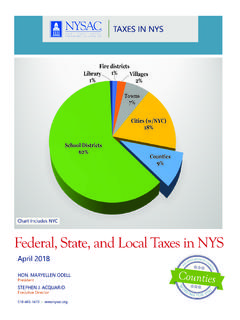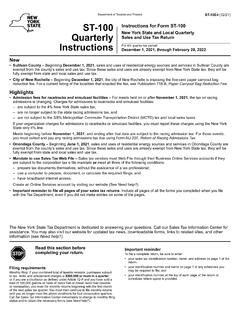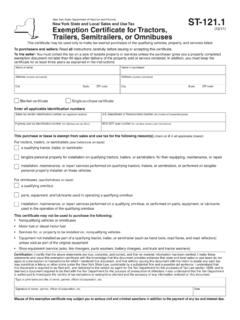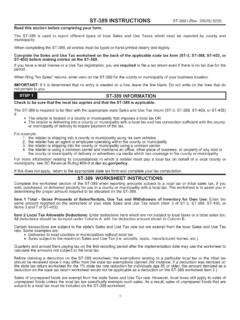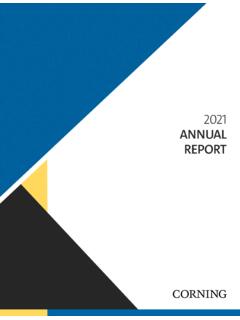Transcription of The Marijuana Regulation and Taxation Act: A Summary
1 The Marijuana Regulation and Taxation Act: A SummaryAPRIL 2021 HON. JOHN F. MARREN NYSAC President HON. MARCUS MOLINARONYSCEA PresidentSTEPHEN J. ACQUARIO Executive Director518 - 4 65 Broadway, Suite 402 Counties Working For You Albany, NY 12207 MRTA SUMMARYS inceSince 2 | NYSAC SPRING 2021 Summary OF THE MRTAS inceSince Executive SummaryOn March 31, 2021, the Governor signed into law the Marihuana Regulation and Taxation Act, (Peoples-Stokes) (Krueger), which legalizes adult-use cannabis with the stated goal of generating significant new revenue. The new law makes substantial investments in communities and people most impacted by cannabis criminalization, reduces the illegal drug market and violent crime, ends the racially disparate impact of existing cannabis laws, creates new industries, increases employment, and strengthens New york s agriculture sector, among other goals. Nothing in this legislation limits the authority of any district, government agency, or office or employers to enact and enforce policies pertaining to cannabis in the workplace, to allow driving under the influence of cannabis, to allow individuals to engage in conduct that endangers others, to allow smoking cannabis in any location where smoking tobacco is prohibited, to require any individual to engage in any conduct that violates federal law, to exempt anyone from any requirement of federal law, or to pose any obstacle to the federal enforcement of federal law.
2 Administration The legislation creates an Office of Cannabis Management (OCM) and Cannabis Control Board. The Board will have five members: a chairperson and two more members appointed by the Governor; a member appointed by the Temporary President of the Senate; and a member appointed by the Speaker of the Assembly. The Board should, to the extent practicable, reflect the geographic and demographic diversity of the state. The Executive Director (ED) of the Office of Cannabis Management is appointed by the Governor, with the advice and consent of the Senate. There is also a Chief Equity Officer (CEO) nominated by the ED, who requires the affirmative support of four of the five members of the Board. In the first year of legalization, New york State expects to receive $20 million in revenue from licensing fees. When the MRTA is fully implemented, the State projects $360 million in annual state revenue and $75 million for local is also an Advisory Board made up of 13 members, with seven appointments from the Governor, six from the Legislature, and the commissioners of the Department of Environmental Conservation, Department of Health, Office of Addiction Services and Supports, and Department of Agriculture & Markets as ex-officio non-voting members.
3 The Advisory Board members must have balanced statewide geographic representation and be diverse in its composition. The appointed members are required to have expertise in several fields relating to health, social equity, and the cannabis and agricultural industries. NYSAC SPRING 2021 | 3 Summary OF THE MRTAP ersonal Cultivation People over the age of 21 can have three mature and three cannabis plants within their private residence, with a limit of six mature and six immature plants per private residence. Plants can be stored within the person s private residence or on the grounds of their private residence. Home growers must take reasonable steps to ensure that the cultivated cannabis is in a secured place and not accessible by anyone under the age of 21. New Yorkers can have up to five pounds of cannabis in their private residence or on the grounds of their private residence. Home growth is not authorized until 18 months after the opening of the first adult-use dispensaries in order to give the regulated cannabis market a chance to develop.
4 Certified medical cannabis patients over the age of 21 and their designated caregivers may cultivate cannabis for their personal use beginning six months after the effective date of the legislation. Counties, towns, cities, and villages can reasonably regulate personal cultivation of cannabis provided that a violation of any Regulation approved by a county, town, city, or village constitutes no more than an infraction and can be punishable by no more than a discretionary civil penalty of $200 or less. Counties, towns, cities, and villages cannot prohibit a person from engaging in personal cultivation. Public Consumption The MRTA allows cannabis to be smoked or vaped anywhere that smoking tobacco is permitted; however, state agencies and localities can more strictly regulate smoking in public pursuant to article 13-e of the public health law. Violations are subject to a civil penalty not to exceed $25 or an amount of community service not exceeding 20 Opt-Out Towns, cities, and villages can opt-out of allowing retail dispensaries and/or on-site consumption via local law, subject to permissive referendum.
5 Towns, cities, and villages have until December 31, 2021 or nine months after the effective date of this legislation, whichever is later, to adopt a local law requesting the Cannabis Control Board prohibit the establishment of retail dispensaries and/or on-site consumption within their jurisdiction. Because the local law is subject to permissive referendum, voters who oppose the law will have the opportunity to gather enough signatures to put the measure on the ballot and potentially override the decision of the town, city, or village government. Town laws will apply to only the area of the town outside of any village within the town. No local law can be adopted to prohibit these establishments after December 31, 2021 or nine months after the effective date of the legislation (whichever is later); however, localities can pass a local law to repeal a previously adopted prohibition after this date. 4 | NYSAC SPRING 2021 Summary OF THE MRTAS inceSince Taxation The legislation imposes taxes on both the distributor and the customer.
6 The distributor of adult-use cannabis products pays a tax based on the per milligram amount of THC. Cannabis flower is taxed at a rate of $ per milligram, cannabis concentrate is taxed at $ per milligram, and edible cannabis products are taxed at $ per milligram. There is also a 9% tax on retail sales that goes to the State and an additional 4% tax that goes to the localities where the dispensary is located (1% is retained by the county and 3% goes to the town, city, or village). The county is responsible for distributing the remaining 3% to cities, towns, and villages based on the proportionate share of sales by dispensaries in each jurisdiction (this will occur on a quarterly basis). If the retailer is located in a village where both the village and town allow cannabis retail sales, then the 3% is split pursuant to an agreement between the town and village. In the absence of an agreement, the 3% is divided evenly between the town and village. Revenue In the first year of legalization, New york State expects to receive $20 million in revenue from licensing fees.
7 When the MRTA is fully implemented, the State projects $360 million in annual state revenue and $75 million for local governments. The legislation establishes a Cannabis Revenue Fund and two additional sub-funds (known as the Community Grants Reinvestment Fund and the Drug Treatment and Public Education Fund) where the revenues will be deposited. The monies in the New york State Cannabis Revenue Fund can be used for: Reasonable costs incurred by the Department of Taxation and Finance for administering and collecting taxes; Reasonable costs incurred by the Office of Cannabis Management and the Cannabis Control Board for implementing, administering, and enforcing the MRTA; Actual and necessary costs incurred by the Office of Cannabis Management, the Cannabis Control Board, and the Urban Development Corporation related to the administration of incubators and other assistance to qualified social and economic equity applicants; Reasonable costs incurred by the Office of Cannabis Management, Department of Criminal Justice Services, State University of New york , and other state agencies will also receive funding for the purposes of data collection and reporting (beginning in FY 2022-23 and continuing through FY 2032-33).
8 Reasonable costs incurred by the State Police and Department of Motor Vehicles to implement the MRTA and to expand and enhance the drug recognition expert training program and technologies used in the process of maintaining road safety; NYSAC SPRING 2021 | 5 Summary OF THE MRTA Reasonable costs incurred by the Office of Cannabis Management, Cannabis Advisory Board, and Urban Development Corporation to administer grants for qualified community-based nonprofit organizations and approved local government entities for the purposes of reinvesting in communities disproportionately affected by past federal and state drug policies (as allowed by the Community Grants Reinvestment Fund); and Reasonable costs incurred by the Division of Criminal Justice Services and the Office of Court Administration to implement the expungement provisions of the MRTA. The remaining monies in the fund will be distributed into the state lottery fund (40%) and two additional sub-funds created within the Cannabis Revenue Fund, known as the Drug Treatment and Public Education Fund (20%) and the Community Grants Reinvestment Fund (40%).
9 The 40% deposited into the state lottery fund will be used for additional lottery grants to eligible school districts and to increase the total amount of funding available for general support for schools. The 20% deposited into the Drug Treatment and Public Education Fund can be used by the Office of Addiction Services and Supports, in consultation with the Department of Health, Office of Mental Health, Office of Cannabis Management, and Department of Education to develop and implement a youth-focused public health education and prevention campaign; develop and implement a statewide public health campaign focused on the health effects of cannabis and legal use; and provide substance use disorder treatment programs for youth and adults. The remaining 40% deposited into the Community Grants Reinvestment Fund can be used by the State Cannabis Advisory Board to provide grants for qualified community-based nonprofit organizations and approved local government entities for the purposes of reinvesting in communities disproportionately affected by past federal and state drug policies.
10 These grants can be used, including but not limited to, to support job placement, job skills services, adult education, mental health treatment, substance use disorder treatment, housing, financial literacy, community banking, nutrition services, services to address adverse childhood experiences, afterschool and childcare services, system navigation services, legal services to address barriers to reentry, linkages to medical care, women s health services, and other community-based supportive services. Adult-Use Cannabis Licenses The legislation outlines several types of licenses that will be available under the adult-use cannabis program, including adult-use cultivator, adult-use processor, adult-use cooperative, adult-use distributor, adult-use retail dispensary, microbusiness, delivery, and nursery licenses. All licenses expire two years after the date of issue. The MRTA places restrictions on the types of licenses a single person can have with the goal of creating a division between those who create the product, those who wholesale the product, and those who retail the product.
